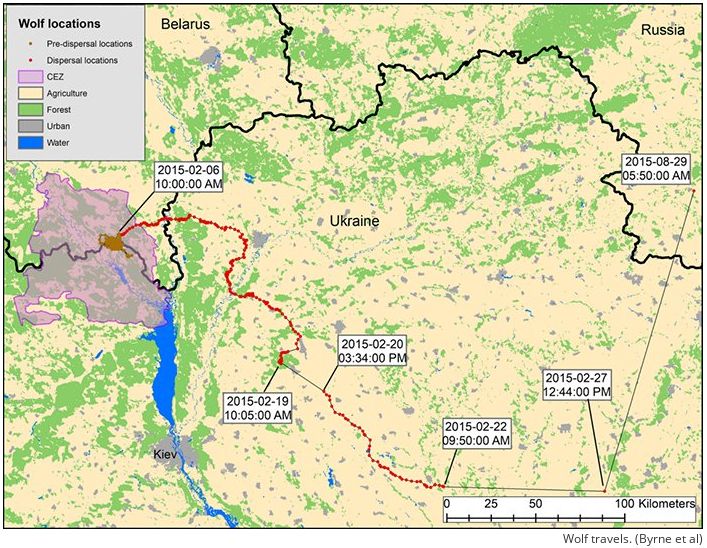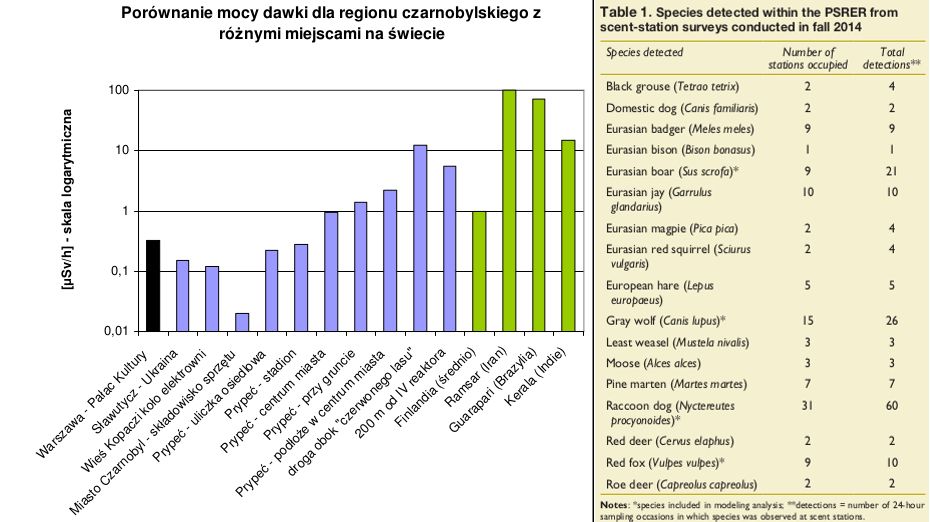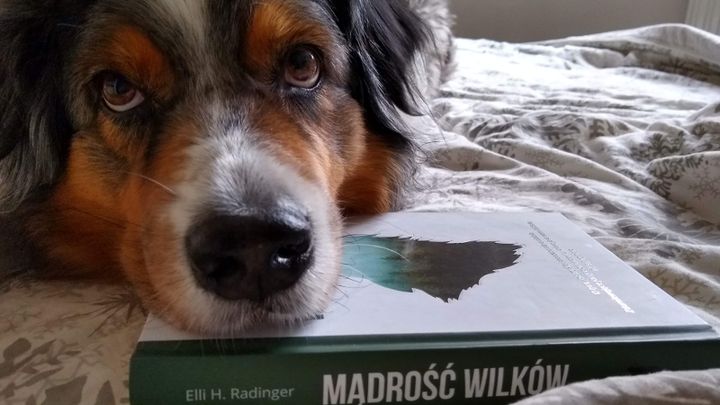A few words about wolves of the Chernobyl Zone
Native fauna and flora species still inhabit the considered - especially by outsiders - as unfriendly dangerous environment, flourishing there without a human factor presence, where approximately 70% is forest (biocenosis) containing water sources like lakes, rivers and marshes (biotope).
In August 2018, the first animal leaving Chernobyl Exclusion Zone was evidenced by scientists. According to the publicized report, a young collared wolf (1-2 years), being a CEZ resident, travelled 365km reaching Russia perimeter territory. The dispersal of a young wolf is an important observation because it suggests that the CEZ may serve as a source for some wildlife populations outside of the CEZ, and raises questions about the potential spread of radiation-induced genetic mutations to populations in uncontaminated areas - the scientists tracked 13 gray wolves (+ the researched one) in the Belorussian CEZ region, equipped with GPS collars before.

Chernobyl Nuclear Power Plant is located on the territory of Ukraine (formerly USSR), nearby Chernobyl (18km) and Pripyat (4km) - formerly a "closed city" settled by Chernobyl NPP workers, currently a "ghost town" abandoned after their evacuation. Its reactors (RBMK) were shutdown one by one as a consequence of the nuclear disaster of 1986.
Initially, radioactive contamination covered 125 000-146 000 km2 of Belarus-Ukraine-Russia cross-border (past USSR) territory, then restricted zones were created. Remaining Chernobyl Exclusion Zone covers 30km radius (2600 km2 area) away from the place of the accident - Reactor 4. Being strict, actual CEZ is divided into subzones - 10km radius circle of abandoned zone with very limited access chance (permission required), and up to 30km radius of irregularly shaped zone which is partly resident. For example - Slavutych, built right after the nuclear disaster, dedicated to immediately evacuated NPP workers with their families and used by presently working scientists, was placed at 60km distance from the ruined reactor (presently staying under New Safe Confinement structure).
Despite the finding of some places where radiation level was high, in general in the so-called CEZ area, radiation dose rate does not diverge from the one measured in Warsaw [as the base radiation rate] - Krzysztof Wojciech Fornalski[1] says, who visited Chernobyl zone in April 9-13th, 2008. /detailed results below (left)/

3 decades passed by. Native fauna and flora species still inhabit the considered - especially by outsiders - as unfriendly dangerous environment, flourishing there without a human factor presence, where approximately 70% is forest (biocenosis) containing water sources like lakes, rivers and marshes (biotope). We observed individuals of 14 mammalian species in total; for those species with sufficiently robust visitation rates to allow occupancy to be modeled (gray wolf [Canis lupus], raccoon dog [Nyctereutes procyonoides], Eurasian boar [Sus scrofa], and red fox [Vulpes vulpes]), we found no evidence to suggest that their distributions were suppressed in highly contaminated areas within the CEZ - previous study (2016), by the same research staff, seems to comfirm it. /detailed results above (right)/
Sergei Gaschak[2] who long-term observes CEZ wildife, also points on the environment destined to prey-predator relations based on reachable habitat - an exemplary niche for a wolf related ecosystem, where ungulates (and the rest of optionally preyed animals) would be hunted by Eurasian wolf as an apex predator. Among them, stray/feral dogs coexist (worth attention form of adaptation), left there by their owners - dwellers from surrounding villages who never came back.
- Red Forest (direct Chernobyl Exclusion Zone)
The most impacted place by radioactive post-NPP-accident fallout, located in the vicinity (4-5km) from the shutdown reactor. Radiation remains there deep in its ground, where dead pine trees were buried - before it, their color had changed into ginger-brown. Present forest zone has become a "Radiological Reserve" including its restored flora and inhabiting fauna.
In the 90's, Przewalski's horses (15 mares and 2 stallions coming from Askania Nova) - which species global population was almost extinct in wildlife - were introduced to CEZ in purpose of restoring the diversity of unrestrictedly growing meadows and potential fire hazard prevention. Their current population - at the beginning researched for a period of time (officially), so far still monitored by scientists (voluntary) - increased locally to 60 individuals.
- Polesie State Radio-ecological Reserve (fraction Belarus)
Established in 1988, to enclose the most affected by radioactive post-NPP-accident fallout territory of Belarus (circa 1313km2), adjoining the Chernobyl Exclusion Zone in Ukraine.
The protected area contains rare/endangered plants (being the objective of the Scientific Department for Ecology of Vegetative Complexes) and animal species (ranking with Berezinskiy Biosphere Reserve), including Przewalski's horses imported from the Ukrainian part of CEZ.
- Chernobyl Radiation and Environmental Biosphere Reserve (fraction Ukraine)
Established in 2016 (30th anniversary), according to the Decree of the President of Ukraine, 60km radius area covering 2/3 of CEZ as a project tasking - among others - scientific research in the field of the environmental protection and radiation monitoring of the territory.[3] Another signed decree made Chernobyl Radiation-ecological Biosphere Reserve state-owned (circa 2270km2) area a UNESCO Biosphere Reserve, supervised by the State Agency of exclusion zone management. The protected area contains 1228 plants and 339 species.
Because of communication issues with the collar, it is impossible for us to say definitively if the movements we observed represented an exploratory excursion (i.e. the wolf eventually returned to its range in the CEZ) or a permanent dispersal - stands in the mentioned evidence by Michael Byrne[4] as the leading author - Research into the magnitude and impact of genetic flow between mammal populations in the CEZ and the surrounding landscape is needed to better understand the role of the CEZ within the context of regional wildlife populations - it concludes.
Yet, there is no evidence that the radiation causes severe mutations in wolves.[5] - That's it.
references:
Evidence of long-distance dispersal of a gray wolf from the Chernobyl Exclusion Zone (2018); research by collective work (incl. Michael E. Byrne)
Influence of radiation on the distribution of four mammalian species within the Chernobyl Exclusion Zone (2016); research by collective work (incl. Michael E. Byrne)
Postępy Techniki Jądrowej [Eng. 'Advances in Nuclear Technology'] (2015; vol.58, no.4, 2015, p.22-26); at the Institute of Nuclear Chemistry and Technology (Warsaw, Poland)
Чернобыль, Припять, зона отчуждения ЧАЭС - Ukrainian website dedicated to Chernobyl, Pripyat, Red Forest and exclusion zone itself.
[1] Krzysztof Wojciech Fornalski graduated Faculty of Physics at the Warsaw University of Technology, being concerned with nuclear/radiation physics, nuclear safety and radiation protection.
[2] Sergei Gaschak is an ex-liquidator after Chernobyl NPP accident, naturalist, CEZ wildlife photographer and author of scientific publications focused on radioactivity and biological impact in the Chernobyl region.
[3] citation after Conservation, Optimization and Management of Carbon and Biodiversity in the Chernobyl Exclusion Zone project
[4] Michael Byrne is researcher (wildlife-habitat relationships) and ecologist (movement/population/behavioral ecology).
[5] citation after European Wilderness Society (Jul 18th, 2018)

